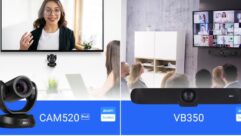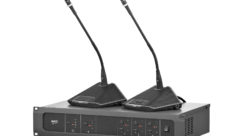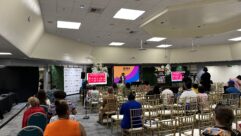
Wide Area Conferencing
THE POPULAR colloquialism, ?They do things big in Texas,? certainly must have a lot to do with physical geography. The University of Texas’ Health Science Center (HSC), based in San Antonio, illustrates that dynamic in the way it virtually links medical, dental, and nursing teaching facilities that are spread out all over the Panhandle, in places like Laredo and down into the Rio Grande Valley as far south as Edinburg. The HSC has built a vast Polycom-based videoconferencing network, connecting more than 60 disparate rooms ? AV-equipped classrooms, lecture halls, labs, and auditoriums, spread out all over South Texas. And it controls it all over a single wide-area network (WAN) from a head-end location on the main campus in San Antonio.
CHALLENGE: Link dozens of classrooms, auditoriums, labs, and lecture halls, spread out over more than 50,000 square miles, on a videoconferencing system, and make it all controllable over a single WAN from one head-end location.
SOLUTION: Rebuild the WAN to support H.323 videoconferencing protocol, provide teleconferencing capability to a large number of AV-enabled rooms, then control AV systems with a network-based system.
THE POPULAR colloquialism, “They do things big in Texas,” certainly must have a lot to do with physical geography.
The University of Texas’ Health Science Center (HSC), based in San Antonio, illustrates that dynamic in the way it virtually links medical, dental, and nursing teaching facilities that are spread out all over the Panhandle, in places like Laredo and down into the Rio Grande Valley as far south as Edinburg.
The HSC has built a vast Polycom-based videoconferencing network, connecting more than 60 disparate rooms — AV-equipped classrooms, lecture halls, labs, and auditoriums, spread out all over South Texas. And it controls it all over a single wide-area network (WAN) from a head-end location on the main campus in San Antonio.
The videoconferencing system itself overcomes a key challenge for the HSC — that is, keeping its medical students connected as it dispatches them to satellite campuses serving the broader South Texas region, positioning them in rural areas in many cases.
University of Texas Health Science Center (HSC) administrators rely heavily on remote software tools like version 6 of Crestron’s Roomview, which enables them to remotely manage AV resources, perform remote system diagnostics, track the usage of projector lamps, log network activity, and automate tasks through event scheduling.
“They use videoconferencing both to provide continuing education to doctors in rural clinics, but also as a means for helping them to stay a part of the (HSC) community. That was the vision that led to this technology,” notes Tom Baggs, who oversaw the development of the HSC’s videoconferencing system. (He left the HSC last year and now works for Crestron as the company’s Southeastern educational markets manager.)
Now, for example, an instructor in the HSC’s newly built neuroscience center, located on the main medical campus in San Antonio, can use a ceiling-mounted Elmo HV-5000XG VGA document camera to digitally capture a series of X-rays. Using a Polycom VSX 8800 videoconferencing codec, students in an HSC classroom located hundreds of miles away in Harlingen can view this X-ray in VGA-native resolution via a 3,500-lumen Sanyo PLC-XP45 LCD projector and a Draper screen. His or her image is captured by a ParkerVision CC-2112-A1N presenter’s tracking camera back at the neuroscience center, and the instructor can be seen simultaneously in composite video on a 32-inch Sony KV32S42 monitor in Harlingen.
HSC classes like this one can be controlled onsite with a Crestron 12-inch color TPS 4500 LB touch-panel. However, for the seven-person staff charged with running this sprawling videoconferencing system, logistics are also a challenge. Tools such as Crestron’s e-Control and RoomView provide remote access to Crestron Pro 2 integrated control processors in the classrooms from the head end.
The HSC has long leveraged the IP-based e-Control, which allows operators to manage all individually addressable AV components connected to the WAN via a web-based interface in the head end. More recently, HSC administrators adopted version 6 of RoomView, which enables them to remotely manage AV resources, perform remote system diagnostics, track the usage of projector lamps, log network activity, and automate tasks through event scheduling.
Currently, the HSC videoconferencing technicians can control 61 rooms with these technologies. “It’s a very large campus,” notes HSC network specialist John Garcia. “It’s not always easy to send a person from one place to another. We rely heavily on these tools to get through our day-to-day operations.”
Wide Area Conferencing
THE POPULAR colloquialism, ?They do things big in Texas,? certainly must have a lot to do with physical geography. The University of Texas’ Health Science Center (HSC), based in San Antonio, illustrates that dynamic in the way it virtually links medical, dental, and nursing teaching facilities that are spread out all over the Panhandle, in places like Laredo and down into the Rio Grande Valley as far south as Edinburg. The HSC has built a vast Polycom-based videoconferencing network, connecting more than 60 disparate rooms ? AV-equipped classrooms, lecture halls, labs, and auditoriums, spread out all over South Texas. And it controls it all over a single wide-area network (WAN) from a head-end location on the main campus in San Antonio.
The IT collision
Of course, developing this sprawling system took time — it was more than a decade in the making. It took resources.
The videoconferencing system went through several stages of evolution, starting with an older system that was integrated into 11 classrooms in 1994 and replaced in ’96 with hardware manufactured by V-Tel. By the time HSC administrators outfitted about 60 rooms with Polycom-based systems — and integrated a Polycom MCG-100 bridge into their head end — more than $6 million had been spent on videoconferencing equipment alone. This isn’t to mention the many millions of dollars more that were spent on IT network upgrades, as well as sound and projection equipment.
And it took cooperation — not only was development of the system backed at the highest levels, but the project took the joint vision of several HSC departments and outside AV systems integrators.
Coordinating it all was Baggs, who joined the HSC under the title of videoconferencing coordinator back in 1996. At that time, the HSC AV staff deployed 31 mobile video teleconferencing carts to its hundreds of classrooms, lecture halls, labs, and auditoriums — and all of those used 35 mm film and overhead slides for presentations.
“It’s a cliché, but when you talk about it, it wasn’t really ‘convergence’ that brought this system together,” Baggs says. “It was more like a collision.”
Starting in the mid-1990s, the school aggressively began upgrading its classroom AV environments as it went about a rather massive building spree, commissioning either new facilities or renovations not only on the main San Antonio campus, but on such satellite campuses as Laredo, Harlingen, and Edinburg. In all, 11 HSC facilities were either built from scratch or retrofitted. Network capability in these buildings was upgraded, too, to include fiber-optic cable.
As the HSC has integrated the latest AV technology into these new rooms, it’s gone back to upgrade the older ones. “They just keep upgrading and upgrading,” notes Doug Winnick, who began working with the HSC while employed by now-defunct Dallas systems integrator Sound Vision Corp. in the late-’90s. He now works with the school as an independent consultant. “Rooms we did way back are now being upgraded with technologies like (Crestron’s) Quick Media (see sidebar).”
Presentations given in HSC classrooms and auditoriums can be remotely controlled from the head end or handled directly by the instructor. This lectern, for example, features a Crestron TPS-2000L touchpanel controller.
Development of classroom AV wherewithal has run hand-in-hand with improvements in IT infrastructure. In 1999, as Baggs was busy overseeing the introduction of modern AV equipment into the HSC’s classrooms, he was also trying to solve a tricky project for the school’s Department of Telemedicine. Specifically, HSC doctors in remote locations needed a better way of communicating mission-critical data to San Antonio — one better than the existing teleconferencing system they currently had, which was very unreliable and required robust operator control on both ends.
“Diagnostic information had to be communicated immediately, but we were only set up with an 8-to-5 videoconferencing crew at the time,” Baggs explains. “If someone in Harlingen wanted a consultation on an X-ray from San Antonio, it couldn’t wait until 2:00 on a Tuesday when we could coordinate everything. It made us recognize the limitations of the current system, and change everything.”
Wide Area Conferencing
THE POPULAR colloquialism, ?They do things big in Texas,? certainly must have a lot to do with physical geography. The University of Texas’ Health Science Center (HSC), based in San Antonio, illustrates that dynamic in the way it virtually links medical, dental, and nursing teaching facilities that are spread out all over the Panhandle, in places like Laredo and down into the Rio Grande Valley as far south as Edinburg. The HSC has built a vast Polycom-based videoconferencing network, connecting more than 60 disparate rooms ? AV-equipped classrooms, lecture halls, labs, and auditoriums, spread out all over South Texas. And it controls it all over a single wide-area network (WAN) from a head-end location on the main campus in San Antonio.
At the time, the HSC’s WAN relied on H.320 protocol, which supported only older telephony-based videoconferencing. H.323 — a more modern protocol for AV data transmission over networks — was just beginning to gain wide acceptance.
“We immediately moved from H.320 to H.323,” Baggs says. “That change ultimately made it possible to bring videoconferencing into the network, and bring control of the classrooms onto the network.”
Transitioning to H.323 meant that “the network guys had to rebuild the WAN architecture,” he notes, with specialized Cisco routers and processors integrated into specific network end-points. In terms of funding, Telemedicine Department needs ranked as high-priority for top-level HSC administrators, who spared no expense to see that they were met.
The same dynamic applied to bandwidth on the WAN — the department’s videoconferencing efforts would be allocated as much of the pipe as it took in order for the system to work effectively. That meant that each facility would receive a dedicated fiber-optic trunk for the transmission of video. “I didn’t understand (network technology), but I knew that if I didn’t fight for enough bandwidth, the system wouldn’t work,” Baggs says.
“With fiber transmission, the picture going in is as good as the one going out,” Winnick adds. “And the doctors were much better able to rely on the images for evaluation purposes.”
Ultimately, due to a variety of factors including liability — and despite the huge investment in establishing the H.323 network wherewithal — the Telemedicine Department abandoned use of the videoconferencing system. However, having spent millions of dollars to upgrade their network, the school’s administrators were quick to recognize the opportunity for the classrooms that were being built at the time.
“When the new classrooms came along, they could just piggyback on the H.323 network backbone that had already been built for the Telemedicine Department,” Baggs explains. “They benefited from the fact that (millions of dollars) was spent to make a run at enabling videoconferencing for telemedicine.”
In the beginning, as they figured out how to use Crestron’s then-new e-Control, HSC network administrators grappled with such issues as security — remote access through e-Control opened up a number of potential security breaches on the network, for example.
“One of the biggest obstacles we faced was opening the firewall to all these various ports and not compromising security,” Garcia notes.
Working with several programmers dispatched by Crestron, HSC network operators were able to overcome these challenges by creating a secure, self-contained virtual LAN (VLAN), which safely sheltered Crestron control processors in the classrooms, conference rooms, and auditoriums from the broader WAN environment.
Wide Area Conferencing
THE POPULAR colloquialism, ?They do things big in Texas,? certainly must have a lot to do with physical geography. The University of Texas’ Health Science Center (HSC), based in San Antonio, illustrates that dynamic in the way it virtually links medical, dental, and nursing teaching facilities that are spread out all over the Panhandle, in places like Laredo and down into the Rio Grande Valley as far south as Edinburg. The HSC has built a vast Polycom-based videoconferencing network, connecting more than 60 disparate rooms ? AV-equipped classrooms, lecture halls, labs, and auditoriums, spread out all over South Texas. And it controls it all over a single wide-area network (WAN) from a head-end location on the main campus in San Antonio.
HSC CLASSROOMS MOVE QUICKLY TO QUICK MEDIA
As control technologies like RoomView and e-Control have evolved, and new classrooms have come online, the videoconferencing system has become bigger, yet easier to manage. And the HSC continues to leverage new technologies that make the system increasingly effective. The latest example is its upgrade to Polycom’s VSX 8800 videoconferencing system, which allows VGA to be transmitted with composite video without being downgraded in resolution. According to Garcia, eight HSC rooms are currently enabled with the new technology, with 12 more coming online by the end of the year.
The upgrade overcomes a challenge for HSC videoconferencing administrators, who have been dealing with complaints from students and instructors who say that some content — text on slides, for example — reproduces poorly onscreen when resolution is reduced to composite video.
“Our biggest complaint with distance education has been, ‘We can’t read the slides,’” Garcia says. “When slides are kept in VGA, you can actually read them.” “The real beauty of this system was the collaboration of supertalented people in the IT department with people in AV and distance learning to make something that’s far better than anything else that could be done with one department acting alone,” adds Baggs.
While its WAN-based videoconferencing system continues to evolve, leveraging the latest codecs and control technologies, the HSC has also taken a forward-looking approach to the AV technology in its classrooms. Recently, the school began converting all of its classroom AV systems to a standard set of designs based on a Crestron’s Quick Media technology, which allows for the consolidation of both devices and cables.
FOR MORE INFORMATION
Ciscowww.cisco.com
Crestronwww.crestron.com
Draperwww.draperinc.com
Epsonwww.epson.com
Parker Visionwww.parkervision.com
Polycomwww.polycom.com
Sanyowww.sanyo.com
Sonywww.sony.com
The first 10 HSC classrooms to use this approach are located in the new Academic and Administration building, which is in San Antonio, just across a walkway from the main medical school. Notable are the six “combination” rooms, which include foldable partitions. These rooms can be used in a smaller, intimate standalone mode to handle about 40 occupants, or opened up and combined with two other rooms to form a larger, videoconferencing-enabled environment that can accommodate about 150.
Their systems are simple and flexible — each room is equipped with an Epson PowerLite 7850 projector and a cluster of JBL Control 26CT ceiling speakers with a single Polycom VSX 7000 videoconferencing system serving all three rooms in group mode. Each room has a Crestron QM-WMC wall plate and a QM-RMCRX receiver/processor — the latter allows all audio, video, and computer cables to be consolidated into a single Cat5 cable, and includes a 20-watt audio amplifier. All three rooms share a single Crestron QM-MD 8×8 matrix switcher, enabling them to be configured in a variety of ways.
The finite number of components and cables allows for more space in combination mode — the rooms are open, and not as cluttered. It also helps to reduce cost.
“In terms of AV equipment, this enabled them to drive down the number of electronic components to the point where they’re not spending $120,000 on a room anymore,” says Tom Baggs, who oversaw the development of the HSC’s videoconferencing system.
Daniel Frankel is a freelance writer based in Los Angeles. He can be reached at [email protected].










